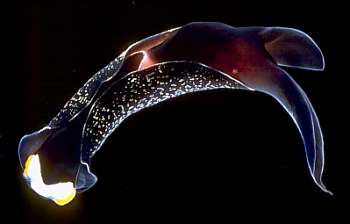

Chelidonura inornata
Baba, 1949
Order: CEPHALASPIDEA
Family: Aglajidae
DISTRIBUTION
Common tropical western Pacific species from Japan to eastern Australia.
PHOTO
Upper: Whole animal. Lower: Underside of the head showing the Sensory Bristles. Coffs Harbour region, northern New South Wales, February 1987.
Photos: Bill Rudman.
The shape of the body is typical for the genus with a pair of rounded lobes on either side of the head. The headshield tapers posteriorly to a rounded point, The posterior shield bifurcates posteriorly into a pair of lobes, the left one being longer than the right, both tapering to a pointed tip. The parapodia are relatively large, folding up to partially enclose the body. The general body colour is a purplish black, with minute white dots densely scattered over the outer surface of the parapodia and on the sole of the foot. The parapodia are also edged in white, sometimes with a continuous white line but often with a broken line. There is usually a broad white band across the front of the head-shield, and there is a yellow or orange edge to the antero-lateral lobes. The eyes are situated on the inside edge of the lateral lobes, in a translucent area devoid of black pigment. The patch often appears blue.
References:
• Baba, K. (1949) Opisthobranchia of Sagami Bay. Iwanami Shoten, Tokyo. 211pp + pls.
• Rudman, W.B., 1970. Chelidonura inornata Baba and C. electra sp.nov. from the Solomon Islands (Opisthobranchia, Aglajidae). Journal of the Malacological Society of Australia, 2: 7-12.
Rudman, W.B., 2003 (May 29) Chelidonura inornata Baba, 1949. [In] Sea Slug Forum. Australian Museum, Sydney. Available from http://www.seaslugforum.net/find/chelinor
Related messages
Chelidonura inornata feeding?
March 29, 2007
From: Leanne & David Atkinson
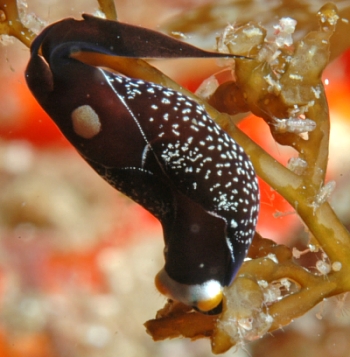
Hi Bill,
We came across this Chelidonura inornata while diving at Jervis Bay with Ocean Trek. It was at the top of a piece of weed so obviously wasn't there by mistake. When we looked at the photos on the computer screen the weed is covered in tiny transparent prawn like creatures, possibly copepods? In one photo the head and feelers of a copepod is protruding from the mouth of the Chelidonura inornata. Other messages you have on the Chelidonura inornata page talk about the possibility of them eating flatworms. Could it have a varied diet and eat these as well? What do you think is it feeding on?
Locality: Bowen Island, Jervis Bay, 12 metres, Southern New South Wales, Australia, Pacific, 17 March 2007, Large boulders with scattered sponges, ascidians, kelp, gorgonias and algae.. Length: Approximately 10mm. Photographer: Leanne & David Atkinson
Regards,
Leanne & David Atkinson
atk@hunterlink.net.au
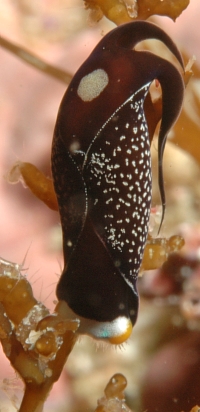
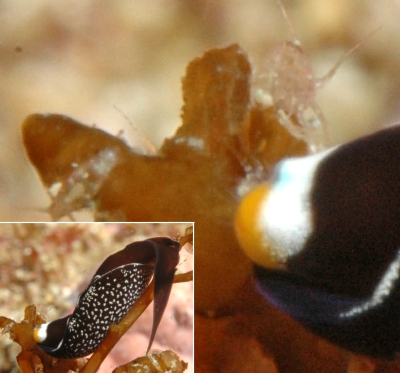
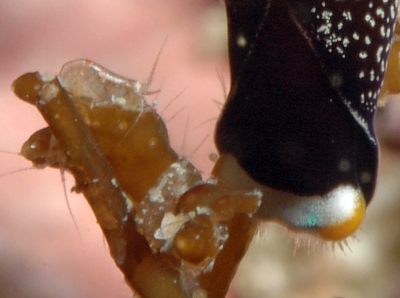
Dear Leanne & David,
Although it's always possible they could eat little crustaceans, the only evidence we have at present is of them eating little flatworms. In your photo [middle right] it looks as though the crustacean is half in the mouth of the slug, but it could also be that the slug's head is hovering just above the crustacean. One reason I doubt that your photo is evidence that the crustacean is their food, is the way aglajids feed. All aglajids lack radular teeth, so they ingest their food either by sucking it in very quickly [Melanochlamys, Navanax] or by partially everting the buccal bulb and enveloping the prey [Philinopsis, Aglaja]. From the small and muscular buccal bulb of Chelidonura, I would predict that it sucks its food in very quickly. If this is the case, I doubt if you would be able to take a photo with its food half out of its mouth. If you were able to catch the actual moment, the food would be a blur, not so clearly in focus.
I have included the close-up alongside, not because it helps answer the question, but because it shows the sensory bristles on each side of the mouth very nicely.
Best wishes,
Bill Rudman
Re: Chelidonura inornata in sthn NSW
March 15, 2006
From: Francis Hawkshaw

Concerning message #16099:
Hi! Bill
I wanted to verify if the Chelidonura inornata in my earlier message had a blue bar below the white area as I described so I went back today to verify this.
I took a clean sterilised glass jar, filled it with sea water from the rock pool where the 2 Chelidonura inornata were grazing, then gently lifted one out of the water with a sterilised plastic spoon and popped it in the jar, took it's photo and gently placed it back in the water where I found it. What an amazing sea creature this Chelidonura inornata is. I thought it had a bright blue bar below the white when I photographed it yesterday, but I was mistaken there was no evidence of a blue bar.
Locality: Gerroa, just below waterline, NSW, intertidal rock pool
Francis Hawkshaw
Kiama
willowhawk@shoal.net.au
Hawkshaw, F., 2006 (Mar 15) Re: Chelidonura inornata in sthn NSW. [Message in] Sea Slug Forum. Australian Museum, Sydney. Available from http://www.seaslugforum.net/find/16110Dear Francis,
Sometimes the colours in opisthobranchs are not caused solely by skin pigments, so colours will change in a single individual depending on its diet, the angle of the light landing on it, and being reflected by it. Chelidonura inornata certainly has a bluish tinge between the white and the black on the head, which is especially obvious as a blue patch on each side over the translucent region above the eyes. Sometimes you can certainly see a bluish band along the black and white border but I suspect it is a 'structural' colour [like a rainbow] rather than a pigment. If you look at other photos of this species on the Forum you will see that many have traces of this blue.
Best wishes,
Bill Rudman
Chelidonura inornata from sthn New South Wales
March 13, 2006
From: Francis Hawkshaw

Black sea slugs.
I have taken these photos of some small sea slugs? in a rock pool near the Gerroa boat ramp on the south coast of New South Wales, Australia.
These small slug- like sea creatures were not large. They had long tails, at first I thought that they only had one tail but the photographs showed two tails. They had white markings on their heads, with what appeared to be large yellow/orange goggle like eyes sockets with a bright blue bar across below these.
Locality: Gerroa, rock pool just under water line, NSW, Pacific Ocean, 12 March 2006, clear sea water intertidal. Length: 1 or 2 inches . Photographer: Francis Hawkshaw.
Can you identify them please?
Francis Hawkshaw
Kiama NSW
willowhawk@shoal.net.au
Hawkshaw, F., 2006 (Mar 13) Chelidonura inornata from sthn New South Wales. [Message in] Sea Slug Forum. Australian Museum, Sydney. Available from http://www.seaslugforum.net/find/16099Dear Francis,
These are indeed sea slugs. This is Chelidonura inornata. Species of Chelidonura are sometimes called 'tailed sea slugs' for obvious reasons. This is usually a tropical species, but it often extends south down the eastern Australian coast to southern New South Wales when warm water eddies from the eastern Australian current move inshore, as they are at the moment, bathing the coast in quite warm water.
Best wishes,
Bill Rudman
Chelidonura inornata from Townsville, Australia
January 25, 2004
From: Paul Osmond
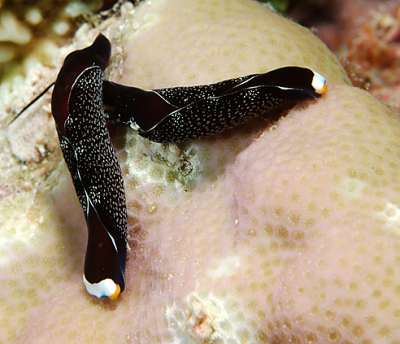
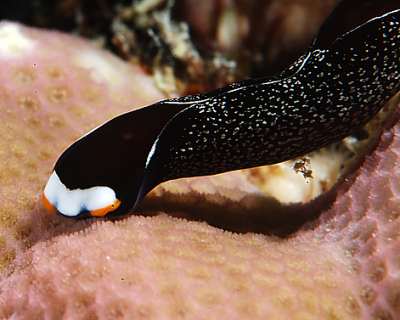
Dear Bill
We found several Chelidonura inornata on several dive sites on the Great Barrier Reef off the coast of Townsville in October 2003.
The pair were hunting as there were a large number of small flatworms nearby.
marriard@deepseaimages.com
Osmond, P., 2004 (Jan 25) Chelidonura inornata from Townsville, Australia. [Message in] Sea Slug Forum. Australian Museum, Sydney. Available from http://www.seaslugforum.net/find/11940Thanks Paul,
It's nice to know what these animals eat. A few years ago most popular reef picture books used to have captions on photos like this saying Chelidonura fed on coral mucus!
Best wishes
Bill Rudman
Chelidonura inornata from Line islands, Kiribati
May 31, 2003
From: Don Barclay
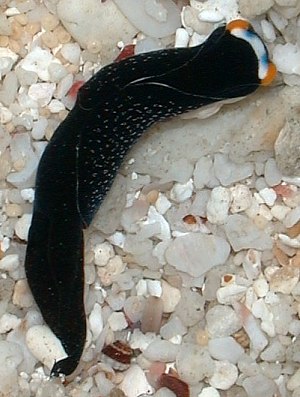
Hi Bill,
Here is a backup for Cory's report of Chelidonura inornata from the Line Islands:
Data: 20 May 2003, about noon (low tide), alongside steel pier, south of London, Christmas Island, Line Islands, eastern Kiribati, in .5m of water, crawling across algal mat on sand; 35mm
Cheers,
Don
barclay@txucom.net
Barclay, D., 2003 (May 31) Chelidonura inornata from Line islands, Kiribati. [Message in] Sea Slug Forum. Australian Museum, Sydney. Available from http://www.seaslugforum.net/find/10092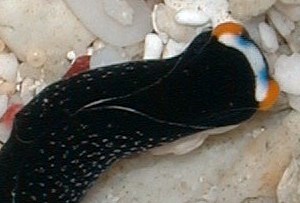
Thanks Don,
It's an opportune moment to get another photo of this species as I am just in the process of commenting on Nils Anthes' interesting messages about C. flavolobata which looks as though it may be an Indian Ocean colour variant of C. inornata or a closely related species.
Best wishes,
Bill Rudman
Chelidonura inornata from Lord Howe Island
January 9, 2003
From: W.B. Rudman
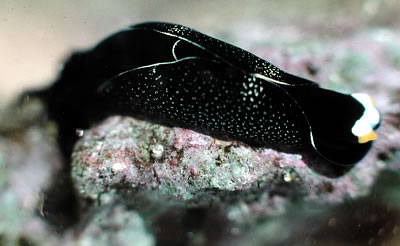

Here is a photo record from Ian Hutton of Chelidonura inornata from Lord Howe Island.
Location: Far Rocks.
Bill Rudman
Rudman, W.B., 2003 (Jan 9) Chelidonura inornata from Lord Howe Island. [Message in] Sea Slug Forum. Australian Museum, Sydney. Available from http://www.seaslugforum.net/find/8825Chelidonura inornata from nthn New South Wales
August 16, 2002
From: John Pogonoski
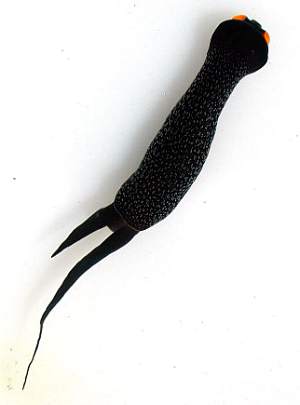
Hi Bill,
Here is another slug that I collected at
Angourie Pool on our recent collecting trip to northern New South Wales, Australia [March 2002].
I suspect that it is probably a species of Chelidonura.
John
johnpog@austmus.gov.au
Pogonoski, J., 2002 (Aug 16) Chelidonura inornata from nthn New South Wales. [Message in] Sea Slug Forum. Australian Museum, Sydney. Available from http://www.seaslugforum.net/find/7773Thanks John,
Yes this is Chelidonura inornata. Your photo shows the ventral surface - it is probably crawling upside down along the surface film. It shows the characteristic orange-yellow patches on either side of the mouth. It is easy with digital images to remove blemishes but I haven't removed the yellow stain at the bottom left of your photo as I suspect it has been secreted by the animal. Just as Sea Hares, such as your Bursatella, secrete a red or purple secretion when disturbed, all aglajids have a yellow secretion.
Best wishes,
Bill Rudman
Chelidonura inornata from the Line Islands
October 24, 2001
From: Cory Pittman
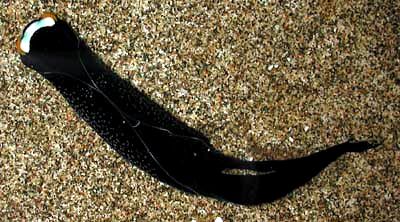
Dear Bill,
During my recent trip to Christmas Island, one of the Line Islands [Sept 2001], I found two of these resting on the surface while wading on a shallow reef platform just off the beach in front of the Captain Cook Hotel. They were at less than 0.5 m. The animal in the photo was about 40 mm in length including the "tail".
Best wishes,
Cory
norm@maui.net
Pittman, C., 2001 (Oct 24) Chelidonura inornata from the Line Islands. [Message in] Sea Slug Forum. Australian Museum, Sydney. Available from http://www.seaslugforum.net/find/5552Thanks Cory,
Bill Rudman
Chelidonura behaviour
October 10, 2001
From: Jeanette McInnes
Dear Dr Rudman,
Thanks for the info re: how many eggs the nudis lay, I've taken notes so I don't forget.
I guess the nudi I saw on RR #10 could have been Dendrodoris nigra, although the one I saw definitely had neon red spots, unlike the one in the Debelius book.
While flipping through readers' letters, I was interested in the Chelidonura correspondence, since the Great Barrier Reef is teeming with Chelidonura inornata. What struck me was the remark that Chelidonura means 'claw tail' (I haven't done classical Greek since '72!). When there's strong current, I've often seen C. inornata hanging on for dear life using what seem to be impossibly small 'toenails', 1 on each tail, so I guessed that was why the Chelidonuras evolved into twin tailed critters; 2 toenails being better than 1, especially when their stomach-foot doesn't seem to be particularly adhesive.
Regards,
Jeanette McInnes.
jlmc01@ozemail.com.au
McInnes, J., 2001 (Oct 10) Chelidonura behaviour. [Message in] Sea Slug Forum. Australian Museum, Sydney. Available from http://www.seaslugforum.net/find/5427Dear Jeanette,
Thanks for the C. inornata observation. Certainly worth checking out,
Cheers,
Bill Rudman
Chelidonura inornata from Coral Sea
October 19, 2000
From: Des Paroz

Hi Bill
Found this one at Eel Gardens, Flinders Reef during my recent Coral Sea trip.
Is it some form of Swallowtail?
Best regards
Des Paroz
www.divesite.paroz.com
des@paroz.com
Paroz, D., 2000 (Oct 19) Chelidonura inornata from Coral Sea. [Message in] Sea Slug Forum. Australian Museum, Sydney. Available from http://www.seaslugforum.net/find/3152Dear Des,
This is Chelidonura inornata in one of its favourite poses - crawling over a coral colony presumably looking for acoel flatworms to eat.
Best wishes,
Bill Rudman.
Chelidonura inornata feeding?
June 8, 2000
From: Akos Lumnitzer
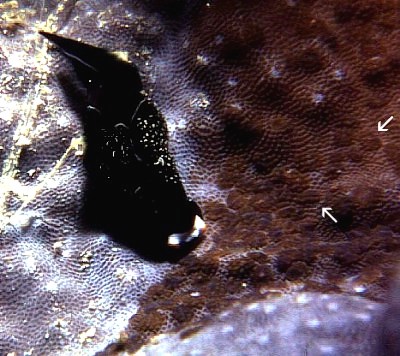
Dear Bill,
Here is Chelidonura inornata from North Solitary Island, September 1998. It was in 15 meters of water. We have also seen these at two places in Sydney [off Shark Point, Clovelly and Oak Park, Cronulla] this season.
Akos.
dna72@softhome.net
Lumnitzer, A., 2000 (Jun 8) Chelidonura inornata feeding?. [Message in] Sea Slug Forum. Australian Museum, Sydney. Available from http://www.seaslugforum.net/find/2525Dear Akos,
I have been asked why I encourage people to send me more photos of species I already have photos of. This photo is a great example of the value of 'more' photos. It may just look like another photo of Chelidonura inornata on Porites coral but I think it is much more than that. Can you see the darker brown patches on the coral? I have pointed an arrow at one of them. They are a cluster? herd? of acoel flatworms, which often occur in 'plague' proportions on colonies of corals and soft corals in the tropics.
For years I have puzzled over why species of Chelidonura are often found, (and photographed), crawling over coral colonies. It seems that they are in fact hunting for these flatworms [see Chelidonura varians page.] which they eat. Your photo is the first one I have seen with a Chelidonura in close proximity to these flatworms. In fact your animal seems to have really struck gold!
Best wishes,
Bill Rudman.
Chelidonura inornata - mating photo
January 30, 2000
From: Mary Jane Adams
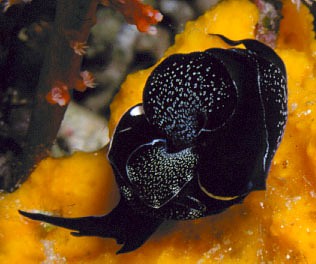
Dear Bill,
Here is a followup photo to my message. It was taken immediately after the two C. inornata met on the orange sponge.
Mary Jane
mjadams@earthlink.net
Adams, M.J., 2000 (Jan 30) Chelidonura inornata - mating photo. [Message in] Sea Slug Forum. Australian Museum, Sydney. Available from http://www.seaslugforum.net/find/1783Chelidonura inornata: mating & trail-following
January 25, 2000
From: M. J. Adams
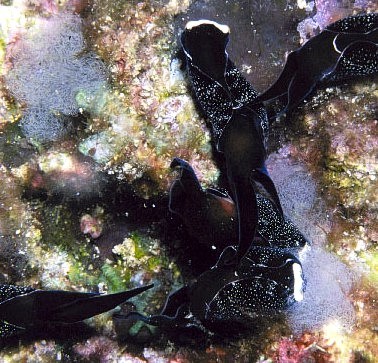
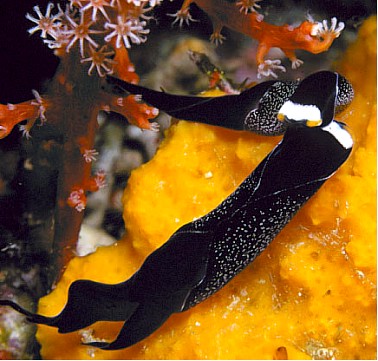
Dear Bill,
I was diving on top of a sea mount in the Solomon Islands when I came across a group of Chelidonura inornata mating and laying eggs. [white patches in photo to right are egg masses with strings of microscopic white eggs].
Nearby was an orange sponge. I was hoping one of the slugs would crawl over the sponge so I could get a photo of it with a contrasting background. To my delight, within a few minutes several C. inornata sped across the sponge, obviously following some unobservable trail. Two slugs that came from opposite directions turned toward each other and, upon contact, instantly wrapped around each other. A slug of another species, Chelidonura electra also traversed the sponge, apparently following the same mucous trail. This all happened within a few minutes.
Has anyone studied sea slug slime? It seems to me that it must contain something like a pheromone that has a very strong attraction for Chelidonura species.
Divesite: "Tuhlagi Twin Tunnels, a coral reef in the Florida Group of the Solomon Islands, 12 meters, November 24, 1999.
The Sea Slug Forum has accumulated an amazing amount of information in a short period of time. What a great way to share experiences from branchophiles all over the world!
Thanks!
Mary Jane Adams
mjadams@earthlink.net
Adams, M.J., 2000 (Jan 25) Chelidonura inornata: mating & trail-following. [Message in] Sea Slug Forum. Australian Museum, Sydney. Available from http://www.seaslugforum.net/find/1776Dear Mary Jane,
Thanks for the great photos and observations. The almost 'instantaneous' mating behaviour when aglajids make contact may be an important behaviour to ensure mating amongst animals that can't see each other or call to each other. Most species of aglajids that I have collected in numbers immediately start mating when kept in confined quarters, such as a collecting jar. I've often tipped out mating chains of 4 or more animals.
Aglajids are all hunting carnivores and I have summarised some of the information in my comments below on a message from Erik Schloegl. Have a look at the Top of Page for a photo of the sensory bristles all aglajids have for following mucus trails. There is also general biological information on the general Chelidonura page and evidence, which unfolded on the Forum, to show at last that species of Chelidonura feed on flatworms.
The first comprehensive study of an aglajid hunting its prey by following mucous trails was Bob Paine's work on Navanax inermis. He showed its specialised feeding on sea slugs, both nudibranchs and bubble-shells. he also showed that when Navanax came across a mucous trail it was just as likely to go the wrong way down the trail.
-
Paine, R.T. (1963) Food Recognition and Predation on opisthobranchs by Navanax inermis. The Veliger, 6(1): 1-9.
Best wishes,
Bill Rudman.
feeding? observations - Chelidonura inornata
September 20, 1999
From: Erik Schloegl
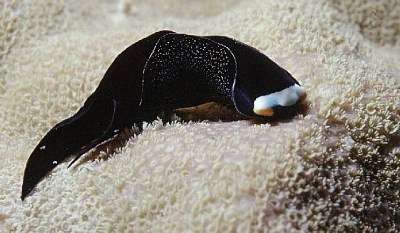
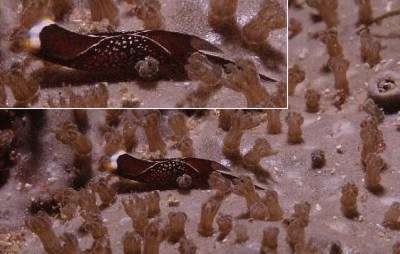
Hi!
Here are two photos of Chelidonura inornata which might be considered interesting... The first photo is of what I assume is an adult (length approx. 4 to 5cm) on a hard coral, at Anderson Reef (Great Barrier Reef) November, 1998. The depth was 7m. There was a whole group of about a dozen of these animals on this particular coral colony, which was about 2m in diameter. I am pretty sure the C. inornata were feeding on the coral polyps, for the following reason: The animal in the photo moved slowly forward from polyp to polyp and it appeared to be grabbing each polyp and then rearing up about a third of its body length, as if ripping the polyp out of its "shell" - I'm now sorry I didn't capture that on film. Each time the C. inornata reared up, there was a quite audible crunching sound.
The second photo shows a tiny C. inornata (less than 1cm long) at a depth of about 15m on rocky bottom at Bowen Island (Jervis Bay, New South Wales). It is perhaps interesting in the sense that C. inornata is usually not found this far south - probably a juvenile washed south by the currents.
Regards,
Erik Schloegl
schloegl@maths.uts.edu.au
Dear Erik,
Thanks for the interesting observations on C. inornata.
If you've read the earlier messages on Chelidonura feeding you will see that the food of Chelidonura has been a bit of a mystery until recently. We have good evidence now to show they feed on flatworms. It is true that in popular books on coral reefs, species of Chelidonura are shown crawling over large coral colonies and at least one book actually states they feed on the coral mucus. I have long suspected they feed on small acoel flatworms which are often found in large numbers on coral, soft-coral and sponge colonies (see my June 1998 reply to Wayne Ellis. We now have observations that they do eat flatworms, so my theory is more plausible. (see message on trail following and the many messages on Chelidonura varians, where flatworm feeding observations are reported). The difficulty with them eating coral tissue is that they have no hard parts in their mouth - no jaw plates or teeth. Their foregut is also designed for suctorial feeding with a rigid, muscular buccal bulb much like the related genus Melanochlamys which feeds on polychaete worms.
It is possible that the 'rearing' behaviour you observed was either the Chelidonura being 'stung' by the coral's nematocycts, or it catching a commensal flatworm on the coral colony. The flatworms are small, up to 5mm long usually and similarly coloured to the animal colony they are living on. On the other hand you could be quite correct. It would be very strange, but perhaps they do eat coral tissue as well.
Now the size differences. Quite a few species of tropical Chelidonura are found at times in mid and southern New South Wales, and although adult (ie: mating and egg-laying) are usually much smaller than tropical animals. In August-September (early spring) there are often large numbers of Chelidonura fulvipunctata and also C. inornata at Long Reef, Sydney. The larvae wash down in currents from the tropical north. Why the animals in temperate waters are much smaller is a puzzle, with many species, the cold water animals are often much larger.
Thanks again for the intersting observations.
Bill Rudman.
Chelidonura from Mooloolaba
June 20, 1998
From: Wayne Ellis
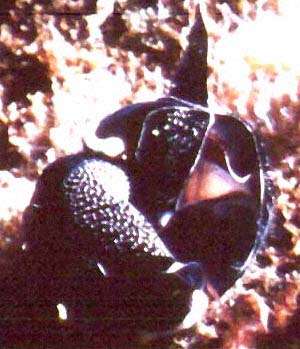
Hi Bill,
Here is another of Steve Grail's photos. It was taken off Mooloolaba, Sunshine Coast, southern Queensland, in 10-20m, between 1996 and 1998.
Regards
Wayne Ellis
glaskin@ozemail.com.au
Ellis, W., 1998 (Jun 20) Chelidonura from Mooloolaba. [Message in] Sea Slug Forum. Australian Museum, Sydney. Available from http://www.seaslugforum.net/find/36Species of Chelidonura are sometimes called the "Tailed Slugs" because of the long pointed tail-like extensions on the posterior shield. The Family Aglajidae consists of carnivorous Bubble Shells in which each genus seems to specialise on a different group of animals as food. The genus Melanochlamys feeds on polychaete worms, and Philinopsis and Aglaja on other opisthobranchs, especially other Bubble Shells. As yet we have no information on what Chelidonura species feed on. Some common species, like Chelidonura inornata, are often seen crawling over living coral colonies. Perhaps they feed on small polyclad flatworms, which are sometimes common on coral colonies and would leave no recognisable gut contents. As with my comments on Sagaminopteron, if anyone has observations on any species of Chelidonura feeding, please let us know. Most aglajids retain a reduced flattened shell hidden beneath their skin in the back half of the body. Aglajids are characterised by their Sensory Bristles which are found in raised ridges on either side of the mouth. The bristles are compound cilia which apparently "smell" the mucous trail of other Bubble Shells, enabling the aglajids to track them down ... Bill Rudman.
Rudman, W.B., 1998 (Jun 20). Comment on Chelidonura from Mooloolaba by Wayne Ellis. [Message in] Sea Slug Forum. Australian Museum, Sydney. Available from http://www.seaslugforum.net/find/36